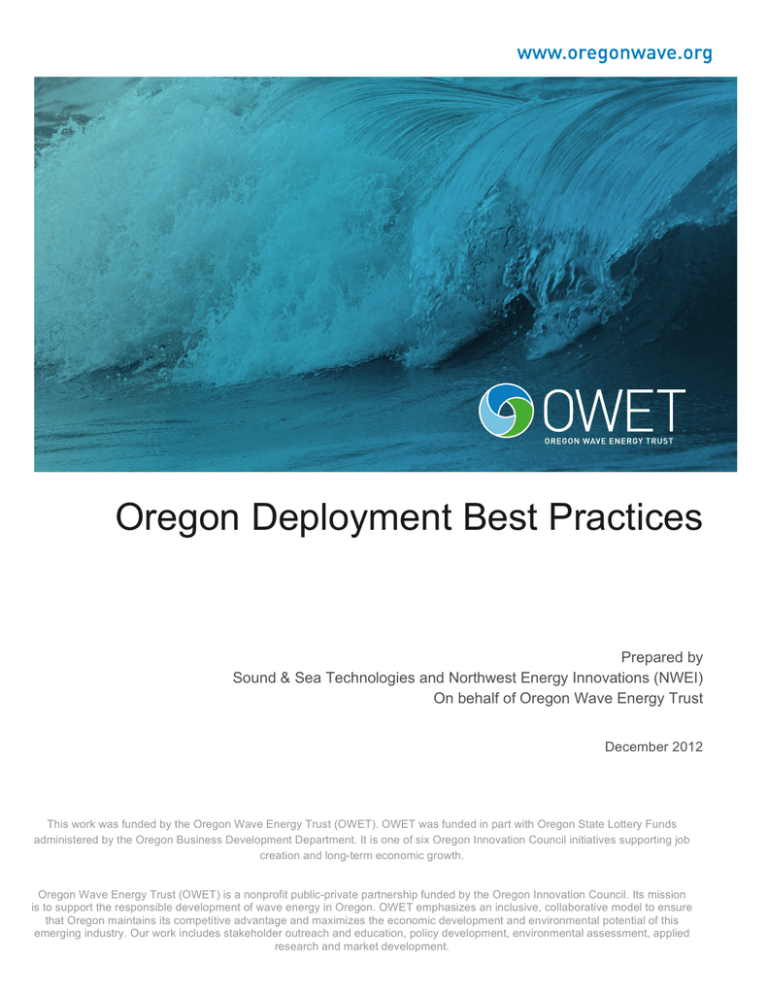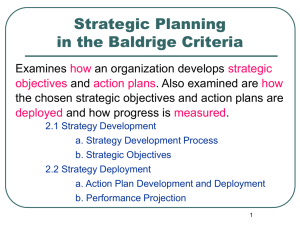Oregon Deployment Best Practices
advertisement

Oregon Deployment Best Practices Prepared by Sound & Sea Technologies and Northwest Energy Innovations (NWEI) On behalf of Oregon Wave Energy Trust December 2012 This work was funded by the Oregon Wave Energy Trust (OWET). OWET was funded in part with Oregon State Lottery Funds administered by the Oregon Business Development Department. It is one of six Oregon Innovation Council initiatives supporting job creation and long-term economic growth. Oregon Wave Energy Trust (OWET) is a nonprofit public-private partnership funded by the Oregon Innovation Council. Its mission is to support the responsible development of wave energy in Oregon. OWET emphasizes an inclusive, collaborative model to ensure that Oregon maintains its competitive advantage and maximizes the economic development and environmental potential of this emerging industry. Our work includes stakeholder outreach and education, policy development, environmental assessment, applied research and market development. Oregon Deployment Best Practices Report Sound & Sea Technology 1 December 2012 Prepared For: Oregon Wave Energy Trust Prepared By: Bill Daly and Carl Gowler Contributions By: Northwest Energy Innovations NRC Environmental Wiggins Tug and Barge ORCA Divers Blue Water Engineering 3 1. INTRODUCTION This report is based on the successful deployment and recovery of the WET-­‐NZ device deployed for a period of 6 weeks at the Northwest National Marine Renewable Energy Center’s Newport Test Site. The device was deployed in late August and removed in early October, 2012. Project Manager: Northwest Energy Innovations Deployment Contractor and Coordinator: Sound and Sea Technology Deployment Vessels: NRC Quest, Peggy (Wiggins), OSU Vessels Deployment Team: Oregon State University, Sound and Sea Technology, NRC Environmental, Wiggins Tug and Barge, ORCA Divers, and Blue Water Engineering The project described herein consisted of the WET-­‐NZ device and related mooring equipment and the Ocean Sentinel and its related mooring equipment. The WET-­‐NZ was connected to the Ocean Sentinel via an umbilical cable to transmit power and perform various data and instrumentation experiments. Although there were operations and deployment efforts related to the Ocean Sentential, this report focuses on lessons learned regarding the deployment of the WET-­‐NZ, and wave energy generator. Figure 1: WET-­‐NZ Installed at Newport Test Site. The WET-­‐NZ device was deployed off the Oregon coast in accordance with the following phased schedule. • • • • Mooring legs #1 and #2 deployed on Day 1 WET-­‐NZ device towed to site from Newport Harbor and connected to mooring legs #1 and #2 on Day 2 Mooring leg #3 deployed and connected on Day 2 OSU connected the umbilical cable between the Sentinel buoy and NZ device on Day 3 4 The overall deployment plan was executed accordantly and resulted in a successful outcome. In general, a tight program schedule presented the greatest area of risk. What follows is a listing of specific items for consideration in future deployments of this type and a recommended list of best practices. Figure 2. OSU Sentinel Buoy 2. LESSONS LEARNED and BEST PRACTICES 2.1.1 Design One of the critical issues with deployment is electrical safety when the device is ready to be ‘turned on’. Design should have an indicator on the buoy itself showing if there is or is not power on the device. A convenient, manual way to secure power on the device is also recommended. Best Practices • 2.1.2 Design device for electrical safety upon completed deployment in a such a way that deployment contractors can easily determine if the device is operating. Planning Crew Experience. It is always best to use vessels experienced with this type of operation. Given this nascent industry, experience with wave energy devices is limited. However, there are multiple contractors experienced in handling equipment and vessels similar in nature. The NRC QUEST (Figure 3) was a vessel of opportunity in the Newport/Astoria area. This vessel was inspected by experience personnel and was determined to be suitable for deployment. Although she is suited for this kind of work, she is normally used as an oil spill response vessel and her crew doesn’t normally handle equipment for this kind of deployment operation. 5 Figure 3. NRC Quest The vessel crew did a good job under the direction of their experienced deck boss. However, the lack of experience of the crew could have been more of a problem if the weather had not been extremely good. Best Practices • • • Oversize the vessel requirements Identify and certify an experienced crew Review and plan for contingency operations Insurance. Advance planning should include verification that appropriate insurance coverage has been arranged. Different vessels and operations require different types of insurance. Although what seems as relatively obvious, there are many complexities with making sure the appropriate insurance is procured for all parties involved. Best Practices Identify project specifics as early as possible Request insurance and contract information from all contractors Schedule • • 2.1.3 All projects of this scope and scale would benefit from a longer schedule. The WET-­‐NZ program was on an extremely tight schedule from the beginning, driven primarily by the need to get the device installed and recovered before the winter weather set in. The deployment went extremely well do to careful planning and in part due to the exceptional good weather conditions. Future deployments in Oregon or elsewhere should not count on fair weather conditions. 6 Best Practices Plan for weather contingencies Allow for project delays Material Procurement • • 2.1.4 It is critical that all contractors involved understand critical path issues regarding schedule and overall material procurement. As early as possible, inform suppliers on the critical path, time constraints for procurements, and not-­‐later-­‐than shipping dates and then monitor progress closely. Best Practices 2.1.5 • • Communicate project schedule with all parties involved Allow for additional time in anchor/material procurement Equipment Thoroughly qualify all equipment as fit for service prior to commencement of operations. For example, The NRC QUEST Manitowoc 390 winches were not able to pay out smoothly or ‘feather the load’ under the weight of the anchor load. For this project, this created a snap load condition on the rode. If the schedule had allowed, the winch would have been serviced to see if the control could have been improved. The winches are in excellent condition and it was surprising that the brakes were so rough. Again under adverse conditions the rough brakes would have increased the risk to safety during load handling. Best Practices • • Test all equipment prior to operations If possible, conduct sea trials of all ocean going equipment Figure 4. Vessel Deck Winch 7 2.1.6 Pre-­‐Deployment Deployment Plan. Schedule as much as possible to develop and review deployment plans and operations. An overall program procedure that included all elements of the deployment will reduce the risk of missing important details. The overall procedure should include all aspects of deployment. Meetings. All important elements in the deployment plan need to be identified and finalized well in advance of deployment in order to minimize risk. Safety meetings and project briefings should be planned to be as extensive as possible. Device Assembly. Final assembly needs to be adequately planned and scheduled for to ensure proper function. Dockside Tests. Ideally, devices should be tested dockside. As an alternative to dockside testing, the devices could be towed to a deep water site with a tug and wet-­‐tested prior to full deployment. For future projects, this alternative should be considered before the expense and commitment of a full deployment is made. In this way, valuable time set aside for offshore testing can be maximized and not be spent repairing or fixing non-­‐operational parts. Hardware Interface Test. For this project, a fitment check of the all the mooring hardware was done as the equipment was delivered to the NRC QUEST. A fitment check several weeks before deployment would have reduced this schedule risk. Best Practices 2.1.7 • Develop plans and coordinate well in advance of final deployment • Test the equipment as best as possible prior to ocean deployment Deployment Operations Mooring Legs. Plan for and execute as many preliminary exercises with mooring equipment in advance of deployment. Station all mooring equipment on the vessel in advance of deployment. All anchors should be positioned on deck to avoid the working wires. Plan for vessels to remain on site until mooring system and device is placed in its final location. A rigging or mooring locker with spare shackles, slings, and typical mooring line connecting hardware is recommended on vessels that are not outfitted with their own inventory of spare mooring hardware. Best Practices • • • Practice deployment protocols in advance Allow additional time for vessels to remain on site Secure spare parts for all aspects of deployment. 8 3. CONCLUSIONS Although a majority of above recommended best practices seems relatively obvious, the experience at the Newport demonstrating that during the final stages of the project, things can become extremely complex. Careful planning will always pay big dividends and save time and money, while ensuring the highest likelihood for success. Figure 5. WET-­‐NZ Deployment 9





